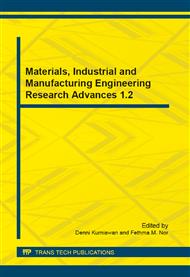[1]
X. Guo, G.T. Fei, H. Su,L.D. Zhang, High-performance and reproducible polyaniline nanowire/tubes for removal of Cr(VI) in aqueous solution, J. Phys. Chem. C. 115(2011) 1608–1613.
DOI: 10.1021/jp1091653
Google Scholar
[2]
M. Sprynskyy, B. Buszewski, A.P. Terzyk,J. Namiesnik, Study of the selection mechanism of heavy metal (Pb2+, Cu2+, Ni2+, and Cd2+) adsorption on clinoptilolite, J. Colloids Interface Sci. 304 (2006) 21-28.
DOI: 10.1016/j.jcis.2006.07.068
Google Scholar
[3]
A. Sar, M. Tuzen, D. Cıtak, M. Soylak, Adsorption characteristics of Cu(II) and Pb(II) onto expanded perlite from aqueous solution, J. Hazard. Mater. 148 (2007) 387–394.
DOI: 10.1016/j.jhazmat.2007.02.052
Google Scholar
[4]
K.O. Adebowale, I.E. Unuabonah, B.I. Olu-Owolabi, The effect of some operating variables on the adsorption of lead and cadmium ions on kaolinite clay, J. Hazard. Mater. 134(2006)130–139.
DOI: 10.1016/j.jhazmat.2005.10.056
Google Scholar
[5]
S. Deng, R. Bai, Removal of trivalent and hexavalent chromium with aminated polyacrylonitrile fibers: performance and mechanisms, Water Res. 38(2004) 2424-2432.
DOI: 10.1016/j.watres.2004.02.024
Google Scholar
[6]
M. Pelaez, A.A.D.L. Cruz, E. Stathatos, P. Falaras, D.D. Dionysiou, Visible light-activated N-F-codoped TiO2 nanoparticles for the photocatalytic degradation of microcystin-LR in water, Catalysis Today, 144(2009) 19-25.
DOI: 10.1016/j.cattod.2008.12.022
Google Scholar
[7]
X. Wang, S.O. Pehkonen, A.K. Ray, Removal of aqueous Cr(VI) by a combination of photocatalytic reduction and coprecipitation, Ind. Eng. Chem. Res. 43 (2004) 1665–1672.
DOI: 10.1021/ie030580j
Google Scholar
[8]
S.C. Xu, Y.X. Zhang, S.S. Pan, H.L. Ding and G.H. Li, Recyclable magnetic photocatalysts of Fe2+/TiO2 hierarchical architecture with effective removal of Cr(VI) under UV light from water, J. Hazard. Mater. 196(2011) 29-35.
DOI: 10.1016/j.jhazmat.2011.08.068
Google Scholar
[9]
F. Chen, R. Shi, Y. Xue, L. Chen, Q.H. Wan, Templated synthesis of monodisperse mesoporous maghemite/silica microspheres for magneticseparation of genomic DNA, J. Magn. Magn. Mater. 322(2010) 2439-2445.
DOI: 10.1016/j.jmmm.2010.02.053
Google Scholar
[10]
R. Thapa,S. Maiti, T.H. Rana andU.N. Maiti, Anatase TiO2 nanoparticles synthesis via simple hydrothermal route: Degradation of Orange II, Methyl Orange and Rhodamine B, J. Mol. Catal. A. 363 (2012) 223-229.
DOI: 10.1016/j.molcata.2012.06.013
Google Scholar
[11]
A. Idris, E. Misran and N.M. Yusof, Photocatalytic reduction of Cr(VI) by PVA-alginate encapsulated γ-Fe2O3 magnetic beads using different types of illumination lamp and light,J. Ind. Eng. Chem. 18 (2012) 2151–2156.
DOI: 10.1016/j.jiec.2012.06.011
Google Scholar
[12]
M. Iqbal, A. Saeed and S.I. Zafar, FTIR Spectrophotometry, Kinetics and dsorption Isotherms Modeling, Ion Exchange, and EDX Analysis for Understanding the Mechanism of Cd+2 and Pb+2 Removal by Mango Peel Waste, J. Hazard. Mater. 164 (2009).
DOI: 10.1016/j.jhazmat.2008.07.141
Google Scholar
[13]
A.K. Yewale, F.C. Raghuwanshi, N.G. Belsare, R.V. Waghmare, R.V. Joar, T.S. Wasnik, K.B. Raulkar, A.S. Wadatkar, G.T. Lamdhade, Gas Sensivity of TiO2 Based Thick Film Sensor to NH3 Gas at Room Temperature, Int. J. Adv. Eng. Technol. 2 (2011).
Google Scholar
[14]
A. Idris N.S.M. Ismail,N. Hassan, E. Misran, A.F. Ngomsik, Synthesis of magnetic alginate beads based on maghemite nanoparticles for Pb(II) removal in aqueous solution, J. Ind. Eng. Chem. 18 (2012) 1582–1589.
DOI: 10.1016/j.jiec.2012.02.018
Google Scholar
[15]
F. Sala, F. Trifirò, Oxidation catalysts based on tin-antimony oxides,J. Catal. 34 (1974) 68–78.
Google Scholar
[16]
K. Kabra, R. Chaudhary, R.L. Sawhney, Solar photocatalytic removal of Cu(II), Ni(II), Zn(II) and Pb(II): Speciation modeling of metal–citric acid complexes,J. Hazard. Mater. 155(2008) 424–432.
DOI: 10.1016/j.jhazmat.2007.11.083
Google Scholar


